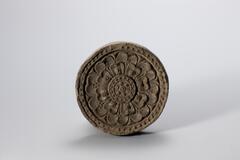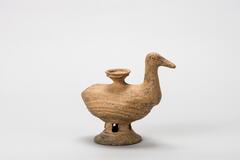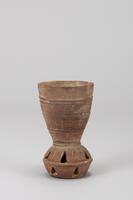22 UMMA Objects
22 UMMA Objects

Korean (Korean (culture or style))
Roof-end tile with lotus design
676 – 935
On loan from the YooGeum Museum, Seoul, Korea
LTL2009.7.7
![This curved tile has small circles lining the edge of the two long, curved edges, and two shorter straight edges without special border decoration. The face of the tile is decorated with vegetal arabesque motif.<br />
<br />
This gray-white, low-fired earthenware concave eave-end roof tile features a scroll design. Although each motif on the front decorative surface of the tile is different, the scroll design demonstrates some degree of left-right symmetry. Traces of a parallel pattern made by a paddle four centimeters wide are visible on the flat surface of the tile. Traces of trimming and smoothing with water are also visible on the sides and joints.
<p>[Korean Collection, University of Michigan Museum of Art (2017) p. 40]</p>
This curved tile has small circles lining the edge of the two long, curved edges, and two shorter straight edges without special border decoration. The face of the tile is decorated with vegetal arabesque motif.<br />
<br />
This gray-white, low-fired earthenware concave eave-end roof tile features a scroll design. Although each motif on the front decorative surface of the tile is different, the scroll design demonstrates some degree of left-right symmetry. Traces of a parallel pattern made by a paddle four centimeters wide are visible on the flat surface of the tile. Traces of trimming and smoothing with water are also visible on the sides and joints.
<p>[Korean Collection, University of Michigan Museum of Art (2017) p. 40]</p>](/media/W1siZiIsIjIwMjEvMDIvMTkvOHh3OXdiaXozOV9kZWZhdWx0LmpwZyJdLFsicCIsInRodW1iIiwiMjQweDIwMCJdXQ?sha=c308a2996283af45)
Korean (Korean (culture or style))
Untitled
676 – 935
On loan from the YooGeum Museum, Seoul, Korea
LTL2009.7.11
![It has a outward-turned rim. The side of the body is becoming narrow in the base. The bottem is flat.<br />
<br />
This yellowish brown, bowl-shaped, low-fired earthenware vessel is made from fine clay mixed with fine sand particles. It has no neck. The mouth is slightly everted while the rim is generally flat and features some grooves. The body is widest towards the upper-middle section, and the flat base is rounded where it joins the body. Parts of the vessel feature a paddled pattern which suggests that the surface was first paddled and then smoothed with water on a rotary device.<br />
[Korean Collection, University of Michigan Museum of Art (2017) p. 44]<br />
It has a outward-turned rim. The side of the body is becoming narrow in the base. The bottem is flat.<br />
<br />
This yellowish brown, bowl-shaped, low-fired earthenware vessel is made from fine clay mixed with fine sand particles. It has no neck. The mouth is slightly everted while the rim is generally flat and features some grooves. The body is widest towards the upper-middle section, and the flat base is rounded where it joins the body. Parts of the vessel feature a paddled pattern which suggests that the surface was first paddled and then smoothed with water on a rotary device.<br />
[Korean Collection, University of Michigan Museum of Art (2017) p. 44]<br />
](/media/W1siZiIsIjIwMjIvMDkvMjQvNjVoNTM5eGtxal9kZWZhdWx0LmpwZyJdLFsicCIsInRodW1iIiwiMjQweDIwMCJdXQ?sha=d9e7c69efc7a919f)
Korean (Korean (culture or style))
Bowl with flat bottom and flat rolled rim
300 – 499
Gift of Bruce and Inta Hasenkamp and Museum purchase made possible by Elder and Mrs. Sang-Yong Nam
2004/1.160

Korean (Korean (culture or style))
Vessel in the shape of a duck
200 – 399
Gift of Bruce and Inta Hasenkamp and Museum purchase made possible by Elder and Mrs. Sang-Yong Nam
2004/1.188
![It has a flat base, globular body and straight neck. There was a bubbling of the clay surface during firing. The attached handle is a little small and thick.<br />
<br />
This is a yellowish gray, low-fired earthenware cup with a handle. The mouth is upright, while the rest of the body has a swollen belly and a round base. The handle attached to the lower middle section of the body is not functional. Traces of rotation and water smoothing are visible on the inner and outer surfaces of the mouth.
<p>[Korean Collection, University of Michigan Museum of Art (2017) p. 68]</p>
<br />
It has a flat base, globular body and straight neck. There was a bubbling of the clay surface during firing. The attached handle is a little small and thick.<br />
<br />
This is a yellowish gray, low-fired earthenware cup with a handle. The mouth is upright, while the rest of the body has a swollen belly and a round base. The handle attached to the lower middle section of the body is not functional. Traces of rotation and water smoothing are visible on the inner and outer surfaces of the mouth.
<p>[Korean Collection, University of Michigan Museum of Art (2017) p. 68]</p>
<br />
](/media/W1siZiIsIjIwMjIvMDkvMjQvMWQybmE1M3FtYl9kZWZhdWx0LmpwZyJdLFsicCIsInRodW1iIiwiMjQweDIwMCJdXQ?sha=618fba87ddd6f364)
Korean (Korean (culture or style))
Small Single-Handed Cup
5th century
Gift of Bruce and Inta Hasenkamp and Museum purchase made possible by Elder and Mrs. Sang-Yong Nam
2004/1.190
![Earthenware roof tile-end with molded lotus design.<br />
<br />
This gray, high-fired earthenware convex eave-end roof tile features a slender thirteenpetal lotus design. It is made from coarse clay mixed with small stone particles. The circular ovary and lotus seeds are depicted in shallow relief, while the lotus petals are slender and lack volume.<br />
[Korean Collection, University of Michigan Museum of Art (2017) p.36] Earthenware roof tile-end with molded lotus design.<br />
<br />
This gray, high-fired earthenware convex eave-end roof tile features a slender thirteenpetal lotus design. It is made from coarse clay mixed with small stone particles. The circular ovary and lotus seeds are depicted in shallow relief, while the lotus petals are slender and lack volume.<br />
[Korean Collection, University of Michigan Museum of Art (2017) p.36]](/media/W1siZiIsIjIwMjIvMDkvMjQvOXVkYnJyYnlyaV9kZWZhdWx0LmpwZyJdLFsicCIsInRodW1iIiwiMjQweDIwMCJdXQ?sha=8f6c2bf6c7b8db77)
Korean (Korean (culture or style))
Roof Tile-End with Lotus Design
676 – 935
Gift of Bruce and Inta Hasenkamp and Museum purchase made possible by Elder and Mrs. Sang-Yong Nam
2004/1.196
![A ceramic lid for a matching bowl. Outfitted with a small, round and tapered handle.<br />
<br />
This yellow, low-fired earthenware vessel consists of a body and a lid. It is made from fine clay mixed with a small amount of fine sand particles. Fine, incised horizontal lines run around the body. The gallery that supports the lid rests at a slight incline, and the vessel mouth slopes slightly inwards. The lower part of the body rapidly tapers inwards before joining the base, the center of which is indented. The lid features a low, flat knob. The round, upper part of the lid meets the lip at a slight angle.[Korean Collection, University of Michigan Museum of Art (2017) p. 45]<br />
A ceramic lid for a matching bowl. Outfitted with a small, round and tapered handle.<br />
<br />
This yellow, low-fired earthenware vessel consists of a body and a lid. It is made from fine clay mixed with a small amount of fine sand particles. Fine, incised horizontal lines run around the body. The gallery that supports the lid rests at a slight incline, and the vessel mouth slopes slightly inwards. The lower part of the body rapidly tapers inwards before joining the base, the center of which is indented. The lid features a low, flat knob. The round, upper part of the lid meets the lip at a slight angle.[Korean Collection, University of Michigan Museum of Art (2017) p. 45]<br />
](/media/W1siZiIsIjIwMjIvMDkvMjQvMm9nbHVzanppOF9kZWZhdWx0LmpwZyJdLFsicCIsInRodW1iIiwiMjQweDIwMCJdXQ?sha=88066081a177047d)
Korean (Korean (culture or style))
Lid for Bowl
400 – 599
Gift of Ok Ja Chang and the Chang Family
2009/2.75B

Korean (Korean (culture or style))
Bell Cup (goblet with rattle base)
5th century
Gift of Bruce and Inta Hasenkamp and Museum purchase made possible by Elder and Mrs. Sang-Yong Nam
2004/1.170
![This lotus medallion design on this round tile-end consists of eight petals. The outer rim is decorated with eighteen round dents. The seedpod contains six peripheral seeds.<br />
<br />
This gray, high-fired earthenware convex eave-end roof tile features a single-tier lotus design. It is made from fine clay mixed with a small amount of sand and is robust in appearance. The central ovary and petals of the lotus stand out in relief. The rim displays a “pearl-dot” (<em>yeonju</em> ) motif depicted in intaglio.<br />
[Korean Collection, University of Michigan Museum of Art (2017) p.36] This lotus medallion design on this round tile-end consists of eight petals. The outer rim is decorated with eighteen round dents. The seedpod contains six peripheral seeds.<br />
<br />
This gray, high-fired earthenware convex eave-end roof tile features a single-tier lotus design. It is made from fine clay mixed with a small amount of sand and is robust in appearance. The central ovary and petals of the lotus stand out in relief. The rim displays a “pearl-dot” (<em>yeonju</em> ) motif depicted in intaglio.<br />
[Korean Collection, University of Michigan Museum of Art (2017) p.36]](/media/W1siZiIsIjIwMjIvMDkvMjQvMmdrajdidWp4Ml9kZWZhdWx0LmpwZyJdLFsicCIsInRodW1iIiwiMjQweDIwMCJdXQ?sha=9077af1495ff16b4)
Korean (Korean (culture or style))
Roof Tile
676 – 935
Gift of Bruce and Inta Hasenkamp and Museum purchase made possible by Elder and Mrs. Sang-Yong Nam
2004/1.197
![This is an example of a lotus medallion with a double layer of petal. Two rows of eight petals each are arranged around a double-ring seedpod. The outer ring of the seedpod has no design. The inner ring of the seedpod contains a central seed surrounded by six peripheral seeds (1+6 seed pattern). The outer rim is embellished with a bead pattern.<br />
<br />
This gray-white, high-fired earthenware concave eave-end roof tile with an eight-petal lotus design was made from fine clay mixed with a small amount of sand. The reverse side shows signs of having been joined to a flat tile, while traces of trimming and smoothing with water are also visible. The round ovary is circumscribed by double lines and contains seven seeds: one in the center surrounded by six more.<br />
[Korean Collection, University of Michigan Museum of Art (2017) p.37] This is an example of a lotus medallion with a double layer of petal. Two rows of eight petals each are arranged around a double-ring seedpod. The outer ring of the seedpod has no design. The inner ring of the seedpod contains a central seed surrounded by six peripheral seeds (1+6 seed pattern). The outer rim is embellished with a bead pattern.<br />
<br />
This gray-white, high-fired earthenware concave eave-end roof tile with an eight-petal lotus design was made from fine clay mixed with a small amount of sand. The reverse side shows signs of having been joined to a flat tile, while traces of trimming and smoothing with water are also visible. The round ovary is circumscribed by double lines and contains seven seeds: one in the center surrounded by six more.<br />
[Korean Collection, University of Michigan Museum of Art (2017) p.37]](/media/W1siZiIsIjIwMjIvMDkvMjQvNWQ2NmVjeHQzYl9kZWZhdWx0LmpwZyJdLFsicCIsInRodW1iIiwiMjQweDIwMCJdXQ?sha=4c7124ce9509ddf0)
Korean (Korean (culture or style))
Roof Tile
676 – 935
Gift of Bruce and Inta Hasenkamp and Museum purchase made possible by Elder and Mrs. Sang-Yong Nam
2004/1.198
![Circular earthenware tile with molded lotus and bosangwha design.<br />
<br />
This dark gray, high-fired earthenware convex eave-end roof tile is decorated with an eight-petal lotus floral medallion. It is made from coarse clay mixed with fine stone particles. The center of the tile is decorated with a double-petaled lotus flower surrounded by eight heart-shaped palmette petals (bosanghwa ) in low relief. Traces of clay used to attach this tile to a flat tile can also be seen on the joints of the reverse side.
<p>[Korean Collection, University of Michigan Museum of Art (2017) p. 39]</p>
Circular earthenware tile with molded lotus and bosangwha design.<br />
<br />
This dark gray, high-fired earthenware convex eave-end roof tile is decorated with an eight-petal lotus floral medallion. It is made from coarse clay mixed with fine stone particles. The center of the tile is decorated with a double-petaled lotus flower surrounded by eight heart-shaped palmette petals (bosanghwa ) in low relief. Traces of clay used to attach this tile to a flat tile can also be seen on the joints of the reverse side.
<p>[Korean Collection, University of Michigan Museum of Art (2017) p. 39]</p>](/media/W1siZiIsIjIwMjIvMDkvMjQvM255Z3pueDhnNl9kZWZhdWx0LmpwZyJdLFsicCIsInRodW1iIiwiMjQweDIwMCJdXQ?sha=7079d07ccd567174)
Korean (Korean (culture or style))
Roof Tile-End with Lotus and Bosanghwa Design
676 – 935
Gift of Bruce and Inta Hasenkamp and Museum purchase made possible by Elder and Mrs. Sang-Yong Nam
2004/1.201
![The decoration of this tile-end consists of lotus medallion with eight petals in the center surrounded by eight heart-shaped bosanghwa(Buddhist floral pattern) just inside the rim. The rim is decorated with a chain of beads.<br />
<br />
This yellowish gray, high-fired earthenware convex eaveend roof tile features an eight-petal lotus floral medallion design. It is made from fine clay and robust in appearance. The tile features a central two-tier, eight-petal lotus design, surrounded by a palmette (or bosanghwa ) design, consisting of eight heart-shaped petals, in low relief.
<p>[Korean Collection, University of Michigan Museum of Art (2017) p. 40]</p>
<br />
The decoration of this tile-end consists of lotus medallion with eight petals in the center surrounded by eight heart-shaped bosanghwa(Buddhist floral pattern) just inside the rim. The rim is decorated with a chain of beads.<br />
<br />
This yellowish gray, high-fired earthenware convex eaveend roof tile features an eight-petal lotus floral medallion design. It is made from fine clay and robust in appearance. The tile features a central two-tier, eight-petal lotus design, surrounded by a palmette (or bosanghwa ) design, consisting of eight heart-shaped petals, in low relief.
<p>[Korean Collection, University of Michigan Museum of Art (2017) p. 40]</p>
<br />
](/media/W1siZiIsIjIwMjIvMDkvMjQvN2Vzb3hndzhtal9kZWZhdWx0LmpwZyJdLFsicCIsInRodW1iIiwiMjQweDIwMCJdXQ?sha=a11d47260113b54c)
Korean (Korean (culture or style))
Roof Tile
676 – 935
Gift of Bruce and Inta Hasenkamp and Museum purchase made possible by Elder and Mrs. Sang-Yong Nam
2004/1.202
Loading…
